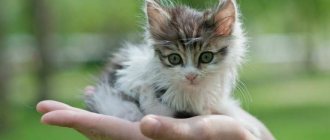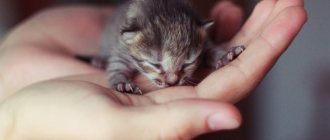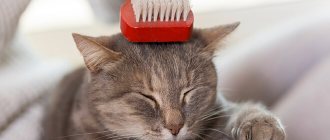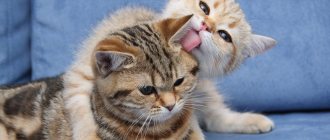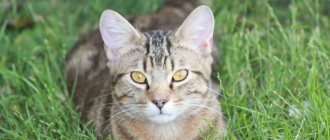Save the article:
When a small kitten appears in the house, it needs help to adapt to new conditions. The psychological comfort and health of the baby depends on this. To ensure that your furry pet’s life runs smoothly, a set of essentials is prepared for him. Great importance is attached to hygiene procedures, good nutrition, and timely vaccination. Caring for a kitten is not difficult if you follow all the rules of keeping recommended by veterinarians.
What does a kitten need first?
There are a number of items that you should acquire before you bring a kitten into your home. First of all, this is, of course, the cat's litter box.
cat litter
A regular tray is a closed or open plastic container with high edges, filled with special compounds. At the genetic level, cats feel the need to bury traces of their vital activity, so they are attracted to loose litter on their own. In addition, living in a confined space, cats tend to go to the toilet in the same place, especially if this place is cleaned regularly.
Sand of various sizes, absorbent granules and sawdust are used as filler. What should you choose? It is better to choose experimentally. For animals, as a rule, there is not much difference. However, owners of long-haired cats are not recommended to use sawdust - it remains on the fur.
Today, automatic trays filled with absorbent granules are also sold. Although it would be more correct to call them semi-automatic, because human participation in their work is still necessary. However, they eliminate the need to react to every animal’s trip to the toilet, which is especially valuable for lazy owners and squeamish cats, or if you have to go on long business trips and there is no one to take care of the cat.
Kitten in an open plastic tray
Bowl
Any dish from which it will be convenient for the animal to eat and drink is suitable as a cutie. These can be saucers, enamel bowls, purchased plastic feeders. Of course, they need to be washed regularly. The degree of regularity depends on the circumstances, but no one has ever gotten worse from maintaining hygiene.
Today, automatic feeders and drinkers are available on the market. This can be convenient for developing the cat's habit of eating at the right time. It also helps with gluttonous animals that are always begging you for food and get offended if you don’t give it. This is also convenient for those, again, who are forced to be away for a long time and have no one to leave the cat with - an automatic feeder will allow the animal to wait out your absence without any problems, especially when combined with an automatic tray.
Kitten drinks from a bowl
House and scratching post
Cats feel safe by “hiding” in boxes, under blankets, in closets - they need some kind of enclosed space. So a cat house out of a box is almost an ideal option.
Today, entire “playgrounds” with a house, places for climbing and grinding claws are sold. Alas, practice shows that cats prefer to climb cabinets and sharpen their claws on carpets and furniture. So it’s more practical to organize a box of rags in a cozy place and a separate scratching post.
The cat looks out of his house
Hygiene items
Cats need to have their nails trimmed. So you will need a nail clipper. There are, of course, special devices, but manicure nail clippers are perfect for this role.
Animals also need to brush their fur, so you will need a brush. The choice of accessory depends on the length of your animal's fur and, more importantly, its individual preferences, so there is no definite solution. You have to try.
For bathing, you will need regular towels and a special shampoo, the choice of which, again, depends on your budget and the characteristics of the animal. To clean your ears, which with normal health and a home lifestyle requires no more than once a month, ordinary swabs with cotton swabs, which you probably use to clean your ears yourself, are suitable. Some owners also brush their cats' teeth - this procedure is also not carried out more than once a month, and to carry it out you will need a special toothbrush and toothpaste. We will look at hygiene issues in more detail below.
A kitten uses a scratching post on which toys are hung
Carrying
You will definitely need a container to transport the animal, for example, to the veterinarian or for a walk to get some fresh air. For these purposes, it is best to use ready-made carriers, which you can find in a sufficient assortment at your nearest pet store.
Some people carry cats in a backpack or bag, but keep in mind that the animal needs oxygen and light, and on the way it will most likely be very nervous, so when calling the cat’s “meow” you need to look at the pet, pet it and something speak in a soothing tone.
What to greet a kitten with
English folk wisdom says that, according to the cat, all things belong to cats. There is a grain of truth in this statement. But still, before you bring a kitten, you need to purchase several things that will belong exclusively to your future “relative”.
So - a small reminder “How to care for a cat and what should be purchased by the time a kitten appears in the house.”
Tray
No one has canceled natural needs and it is unlikely that anyone wants a kitten to relieve itself in an apartment, in a secret corner. Street cats, of course, do not know comfort, but indoor kittens (and especially their owners) need a proper cat litter box first and foremost.
In short, there are three types of trays:
- closed (so-called Eurotoilet);
- open with filler;
- open without filler with lattice;
The first (closed) are aesthetically pleasing, but expensive. This type of litter tray requires a gel or silica gel filler that blocks odor. The advantages of this type of tray are obvious - they are discreet, tidy and pleasant in appearance. One of the disadvantages is the large size of the toilet, for which there may simply not be room in the house!
The open type of tray with filler is the most common and, perhaps, convenient for apartments and for a four-legged baby. Recommendations from “experienced” people are unanimous that there is no need to buy a small tray for a kitten. Regardless of age, the baby will overcome the high sides and you will save on constantly changing toilets. So immediately buy a tray “for growth”, especially since any fillers are suitable for this type and they are very easy to disinfect.
Advice to purchase a tray without filler with a grid is addressed to those who are constantly at home and can often rinse the grid and the tray itself. From time to time, flush the toilet with special products containing chlorine, and may the absence of odor and a happy kitten be with you!
Read how to train a kitten to use the litter box.
There are also special trays for accustoming a kitten to a human toilet.
Read how to train a kitten to use the toilet.
In the video you can learn the general rules for those who don’t mind sharing a “white friend” with their animal:
Toilet filler
Keeping a kitten will be comfortable for both of you if the kitten likes the litter, in a figurative sense, of course. Although, if you observe a one-month-old kitten, you will find that he will probably try the filler on his tooth.
There are three types of fillers:
- locking;
- clumping;
- absorbent.
The burying instinct, inherent in the kitten by nature, should be realized at the moment when he “powdered his nose.” Therefore, do not skimp on the filler, let the baby dig up enough and, therefore, enjoy going to the toilet.
Locking fillers are considered the most economical This filler is poured in large quantities into a tray, moisture flows down the granules and is absorbed only in the lowest layer. The top layers remain clean and prevent odor from spreading. When most of the surface turns yellow, the filler is refreshed.
Clumping filler dissolves with moisture, forming round clumps. They are removed with a special sifting spatula, and filler is added as needed.
Absorbent fillers are the most inexpensive and environmentally friendly. They are made mainly from sawdust, paper, etc. You can also remove it in parts, as it gets dirty.
Dishes
Let the Saxon porcelain set continue to stand in the sideboard, as a memory of your great-grandmother - for the kitten you need to purchase only three bowls in advance (by the way, porcelain ones are also possible). One bowl is needed for water. It should be as stable as possible. The other two are for dry food and for liquid food. Bowls should be easy to clean and comfortable for the kitten.
If you are often away from home for long periods of time, we advise you to buy an automatic feeder and a drinking fountain.
scratching post
If you don’t buy a scratching post or put off this purchase until “later,” then you will have to buy a new sofa or leather corner for the kitchen. And it’s not about the cat’s harmfulness at all! Kitten cats don't just sharpen their claws. This ritual is an exercise for them, without which the animal feels uncomfortable. There will be no scratching post - the baby will replace it with furniture or wallpaper. From the first day, take the baby to a special post or even a complex wrapped in sisal thread, and show the kitten what to do with this happiness.
To consolidate the effect, spray the scratching post with liquid catnip, which is so attractive to cats.
A little patience will ultimately save your furniture and nerves! Try making a cat scratching post with your own hands according to the video instructions.
Combs
Yes, on the dressing table of a decent kitten there should be a comb, or better yet several at once - the rule of caring for kittens. Of course, if your pet is not a sphinx or a charming greyhound. Human hair care products are absolutely not suitable for babies! Plastic combs are also not suitable for them, since they strongly electrify the fur.
Metal scratchers with wide teeth are optimal. Brushes that fit on your hand are very convenient.
IMPORTANT! Try not to use slickers, better known as slickers! They are needed in preparation for exhibitions, and in normal, non-show mode, the kitten’s fur can be greatly damaged by the slicker.
Toys
The baby needs toys. Like any baby, a cat child will look for a toy. It could be a gold ring left out of habit under the mirror or a torn button. Therefore, buy a couple of toys in advance. Balls, fur mice, rattles or feathers on a stick will help the kitten brighten up the first days of separation from its mother cat. Or make your own cat toys.
Sprays
Caring for a kitten for 1 month will be quite difficult. Until your patience and love develop acquired instincts in your baby. Special sprays can help with this! They can be repellent or habituating.
You will need the first ones to protect those places that the cat can damage or to wean her from going to the toilet in the wrong place.
Attraction sprays are good for crate training or house training.
These sprays are completely safe for the animal and very effective!
Carrying
Newborn kittens were initially handled by the breeder. From the moment he has handed over the banner of responsibility to you, you will have to visit the veterinarian regularly. Therefore, carrying is simply necessary. It can be fabric or plastic (depending on the size, temperament of the cat and the geography of transportation). For those who are going on a trip by train or plane, a hard plastic carrier is needed; traveling in a car is convenient with a soft carrier.
By the way, while the first trip is still looming in the future, it is convenient to use the carrier as a house for the baby. Place a diaper in it that smells like its first home and the kitten will feel safe in the carrier.
Toothbrush and toothpaste
Problems with teeth and gums in cats often lead to serious illnesses. You need to start caring for your baby’s oral cavity from a young age. Otherwise, later this procedure will be painful for everyone.
Beef or salmon flavored toothpastes and comfortable toothbrushes should relieve possible dental problems. It is very easy to care for a cat that has been accustomed to procedures since infancy.
The video below shows a short dental course:
The first days of a kitten in the house
The long-awaited kitten has been brought. He is scared, cut off from his mother and familiar smells, and does not orient himself in an unfamiliar space. Usually the owner of the nursery gives detailed instructions on the care and maintenance of a British kitten.
Kittens are usually toilet trained at 2-3 months
To make getting used to your new home quick and painless, it is better to act as follows:
- There is no need to grab the kitten, squeeze it and try to immediately teach it to run after a toy - it will struggle, scratch and will perceive its future owners negatively. Therefore, it is better for new owners, especially children, to simply be in the pet’s field of vision, talking to it affectionately and calling it by name. The kitten must be given time to get used to it without scaring it. Soon he himself will come to the owner.
- If the apartment is large, and bowls of food and water and the toilet are located far from each other, then at first they can be placed nearby, but not next to each other. The kitten can be confined to one room for a couple of days, where everything it needs will be located. Then gradually expand the territory, opening doors to other rooms so that he does not get lost and gradually masters the entire apartment.
- In the first days, the animal must be fed with the same food as it was fed in the nursery. The change of food occurs gradually; for this, a new type of food must be gradually mixed into the usual one.
- Kittens are usually toilet trained at 2-3 months. The baby should be shown where his new toilet is by placing a napkin with the smell of his urine there.
The kitten needs to be given time to get used to its new home.
Having bought a cat, the owner will have to change his habits, and now:
- do not leave entrance doors open;
- install durable mosquito nets on the windows;
- including the washing machine, check its contents;
- close the toilet lid;
- close cabinets;
- watch where you want to sit.
It is important to be in the field of view of the new pet in the first days
Security
A kitten in the house, regardless of age, requires compliance with certain rules of behavior from family members.
First of all, you need to block off all places that are difficult for humans to reach: if the kitten gets stuck somewhere, you will not be able to help him. Therefore, the places under and behind sofas and cabinets are at risk: it is better to cover them with something. Folded blankets or scrap rags will do.
The apartment must be clean and safe. Chemicals should be removed from wherever a little explorer can reach. This also applies to medications. Check all corners and niches for stray food, toys or small parts. Cleanliness is a guarantee of safety. Make sure your kitten can't eat, drink, or get into anything toxic.
Remember that kittens often sleep in the most unpredictable places. Check where you plan to go next in your life. The same applies to moving heavy objects, opening and closing doors, cabinets, and drawers.
Don’t leave him alone with electrical appliances turned on and remember that a vacuum cleaner and hair dryer are the worst enemies for a cat’s delicate hearing. If he gets scared, he will have to search for a long time.
Until the little miracle begins to climb out of the box on its own, these tips for caring for a kitten may not be needed, but then you can’t do without them.
In fact, many cats remain kittens until old age. Although often, when they grow up, they leave the spontaneity and playfulness of childhood. Catch the moment before your cat becomes a sedate matron and enjoy her antics to the fullest. And remember that forgetting about caring for a kitten up to 12 months old is simply criminal.
Feeding rules
When caring for a newborn kitten, its diet deserves special attention. So, in the first days of his life he does not need additional feeding - he receives all the necessary microelements and vitamins from mother's milk. If we talk about additional nutrition, then it must be started from the 4th week of your pet’s life. The first products allowed to be introduced into a kitten’s diet should be fermented milk products. Moreover, you should choose only those that have low fat content. After a few days, you can also introduce porridge and finely chopped meat into your diet.
In addition, already during this period of growth and development of the animal, it is necessary to make a final choice regarding what type of food you will feed the cat in the future. There are two options: dry food and natural products. If you choose the first option, then it would be useful to consult a specialist at a veterinary clinic. It will help you decide on a specific brand of food, which largely depends on the breed and physiological characteristics of the animal. If you decide to feed your kitten natural food, then remember that you should give him only fresh and high-quality products. Never feed your pet scraps from the owner's table.
Be prepared for the fact that at first you will have to feed your pet yourself, using a syringe or pipette. However, you should not abuse such excessive care - gradually accustom the animal to eating on its own.
Mr. Cat recommends: adaptation of a new tenant
Little kittens adapt to a new environment quite quickly, but your pet needs to make this period as easy as possible. At first he will miss his mother and look for her, but after a few days he will start exploring the expanses of the apartment.
If you do not plan to let your tailed pet into your bed, then it is necessary to accustom him to a house or bedding from the first days.
The animal will choose a place to sleep itself, and a house should be placed there or a special bedding should be laid.
Moving and being separated from mom is stressful for a small animal. At first, he may refuse to eat and drink. You need to accustom him gradually, over time he will begin to eat normally.
The pet will also choose its own place to go to the toilet. He may start meowing loudly while circling in one place. This happens if the nursery or breeder has already trained him to use a tray. Where he has designated a place for himself, the pot is placed. Sometimes a kitten can quietly pee in some corner, and the owner simply will not notice it.
In any case, it is almost useless to accustom a kitten to a tray placed in a place chosen by the owner: he will go to the place where he did it for the first time.
In this matter, a person will have to adapt to a small pet. If the cat is not accustomed to the tray, then he needs to be shown several times what this item is intended for: as soon as the animal begins to “dig” a hole for its business, you need to place it in the tray.
Visit to the veterinarian
When purchasing a pet, you should carefully read the reviews of visitors to nearby veterinary clinics and choose the right one.
The first vaccination for a kitten is given at 12 weeks.
If British breed kittens are cared for correctly, visits to the veterinarian will not be frequent, but kittens should be seen regularly for examinations and vaccinations during the first year of life.
- Vaccination schedule.
Until a kitten that feeds on its mother's milk is 12 weeks old, there is no point in getting vaccinations, because... With milk he receives antibodies that enhance immunity.
When the kitten is one year old, he is vaccinated against rabies.
At 12 weeks, the baby receives the first comprehensive vaccination, which includes components against rhinotracheitis, calcivirosis, and panleukopenia. The vaccine is fixed exactly after 21 days with a similar composition. When the kitten is one year old, he is given the same vaccination for the third time, and a rabies vaccination is added to it.
Caring for British kittens includes preventive deworming
In the future, the pet is given a comprehensive vaccination and vaccination against rabies every year. Even if the cat is constantly in the apartment, annual vaccination should not be neglected.
- Deworming.
Caring for British kittens includes preventive deworming.
Deworming is mandatory before vaccinations. The procedure must be carried out 10 days before vaccination; the drug can be in the form of a tablet or suspension.
If lice, fleas, scabies mites or lice mites are found on a kitten, it is necessary to treat it with drugs against ectoparasites
Until the kitten is six months old, deworming is carried out monthly.
Once the pet reaches one year of age, worming is carried out once a year.
- Treatment against ectoparasites.
If lice, fleas, scabies mites or lice mites are found on a kitten, it is necessary to treat it with drugs against ectoparasites. The products are available in the form of sprays, powders, drops on the withers - the veterinarian will select the most effective one, because For kittens under 3 months of age, only short-acting medications can be used.
For kittens younger than 3 months, only short-acting medications can be used.
Kitten health
Once you get a kitten, start listening to word of mouth
After all, it is very important to find YOUR veterinarian! Based on the advice of friends or reviews on the Internet, it will not be difficult for you to do this. At your first meeting, ask your future family doctor about nutritional recommendations, options for fighting parasites, the first signs of disease, and get a schedule of vaccinations and visits to the veterinarian
Deworming a kitten
About 7 days before the first vaccination you need to do deworming. Subsequently, kittens undergo this procedure every three months until one year. It is optimal to use broad-spectrum drugs for the prevention of parasites.
Flea control
Fleas are no joke. It’s especially not funny for the little ones who have these parasites. They cause itching, allergies, dermatitis, lead to exhaustion and the development of blood diseases! Have we scared you? Anti-flea products come in five types: drops, sprays, shampoos, collars, tablets. Do not rely on your choice if your pet is still very young, but consult your veterinarian.
Vaccination
IMPORTANT! It is necessary to vaccinate both animals that live in the yard and those that do not leave the apartment. Both the first and second can get sick equally, so it’s better to be safe
Kittens are vaccinated for the first time at the age of 8-9 weeks. In this case, vaccinations that do not contain the rabies virus are used.
Revaccination is carried out when the kitten is 12 weeks old. This complex vaccine already contains the rabies virus.
The next revaccination takes place once a year and then once every year.
The scheme may change slightly. Your veterinarian will suggest the best one.
Sterilization/castration of an animal
If you are ready for the fact that the kitten, as it grows up, will begin to “mark” its territory, demand a cat (cat) and regularly “bring it in,” then you don’t have to read any further. If this prospect does not make you happy, then let sterilization/castration be the most humane way to solve many future problems.
It is best to castrate a kitten at the age of 9-10 months.
A cat needs to be spayed before its first heat, which is approximately 8 months of age.
To conclude this chapter, we will tell you about the signs that mean your cat is having health problems.
So, what should you always pay attention to? Reasons to contact a veterinarian include: poor appetite, poor weight gain in the kitten, vomiting, bloating, diarrhea, runny eyes, pale gums, cough or shortness of breath, nasal discharge, difficulty urinating
At first glance, it seems that keeping a kitten is very, very difficult. In fact, this is a very pleasant thing, because the word “content”, if you regularly follow all our recommendations, will disappear from your diet and they will become just a way of life. And, believe me, when the fluffy ball settles on your lap and starts his endless “Purrrrrrr”, you will say that it was worth it!
We recommend reading very good books:
- Lyudmila Antonova “Care for domestic cats”;
- Elena Filipova “From a cat’s point of view.”
How to care for kittens without a cat
It happens that the mother died during childbirth, and the owner is left with the blind, squeaking offspring.
The owner will have to replace the kittens' mother:
Heating. A heating pad with water heated to a temperature of 35°C, on which a soft mattress is laid, works well. It is not recommended to place newborns near heating devices or warm them with an infrared lamp. In the first case, this will cause overheating, and the use of lamps may affect vision when babies open their eyes.
Feeding. It is better to buy a cat's milk substitute, but if this is not possible, then you can use cow's milk, adding a pinch of sugar
It is important not to feed formulas with a high percentage of fat in the first weeks. To give food, use a bottle with a nipple or feed with a pipette.
Dishes are washed and sterilized after each meal. Feeding is carried out at intervals of 2-2.5 hours.
Hygiene. To maintain cleanliness, the baby's fur must be wiped with a damp cloth. Bathing at an early age is prohibited. The ears are cleaned from accumulations of wax with a cotton swab, and to care for opened eyes, it is recommended to take an eye wash from a veterinary pharmacy.
Stimulates digestion. After each meal, massage your tummy and sides in a circular motion from the chest to the perineum.
By the third week the kittens will begin to walk
In addition to feeding and care, you will need to pay attention to education: toilet training, showing a scratching post
Kittens grow quickly and what is developed in the first days and weeks of life will become the basis for the behavior of an adult animal.
Choosing a place for a kitten's toilet
Cats try to satisfy their natural needs in an intimate environment, and the place chosen for the toilet in the apartment must meet a number of requirements:
- Availability. The kitten should be able to go to the litter box at any time.
- Privacy. Animals do not like to be looked at while they are emptying their bowels or bladder.
- Comfort. If the baby does not like the litter, then it is almost impossible to force him to go to the tray. It is recommended to take the pellets that were used by the breeder.
Familiar filler and a comfortable environment will allow the kitten to quickly get used to the new place.
Feeding a kitten without a cat - alternative solutions
If a cat feeds her kittens herself, then there are usually no difficulties with their development. But artificial feeding is a rather troublesome task for the owner. It is required to pay sufficient attention to the correctness of its implementation, taking into account the following aspects:
- composition of the selected mixture;
- feeding regimen;
- method of feeding.
To understand whether the kitten has enough food and whether its weight is gaining normally, you need to weigh the babies once a week and keep a diary of weight gain.
Reference!
The minimum increase should be 50 - 100 g every week.
If there are doubts or suspicions of deviations, you should consult a veterinarian.
As a rule, a mother cat successfully copes with feeding 5 or more kittens. But there are times when there is very little milk or no milk at all. In this situation, the owner must find a nurse cat or artificially feed the kittens themselves. It's very difficult.
First of all, patience and proper organization of the daily routine will be required, since newborns require such nutrition every 2 hours for 3 weeks, including at night.
If we talk about the nutrition itself, then formulas that are intended for infants are suitable, but they need to be diluted more strongly than for children. These babies are fed from a pipette.
When a cat cannot feed her kittens, the question arises of what can replace mother’s milk for pets. Nowadays, pet stores sell their mother's milk substitutes specially designed for newborn kittens.
You can also make your own milk mixture. The composition of this recipe is similar to cat's milk. You need to take:
- four parts boiled goat milk;
- one part egg white.
Beat these ingredients until smooth. If you have intolerance to milk sugar - lactose, then you can feed a lactose-free infant formula. Dilute it with water 2 times more than according to the instructions for a child.
The kitten needs to warm the mixture to a comfortable temperature, do not give it hot.
It is prohibited to force feed a kitten. So there is a high risk of food getting into the respiratory tract.
Important,
so that the baby lies in the position in which he sucks the mother’s breast - this way, physiologically, his body absorbs food more easily and belches excess air.
After a month, the kitten is able to digest regular food, so complementary foods are introduced.
How often?
From the first day of life, with artificial feeding, meals are required every 2 to 3 hours, also at night. For each feeding you will need about a teaspoon of the mixture - 5 ml.
Over time, the interval between meals should be increased. From the third week it is 3 hours, and from the fourth week it is four, leaving only daytime feedings.
You can make a supply of milk - but not for more than a day, keep it in the refrigerator, heat it to the optimal temperature before giving it to the baby.
Important!
Special nipples and bottles need to be boiled regularly. The same applies to pipettes and syringes.
The mixture must be supplied evenly, otherwise the animal will not have time to swallow it.
Where to go to the toilet
The most important item, which comes first on any list of this kind, will, of course, be the tray. Long gone are the days when a baby was given a heavy wooden box filled with sand and not smelling like hyacinths. Modern trays can be closed or open, with or without filler, but equipped with a grid.
Closed trays look attractive, do not smell and protect the pussy from indiscreet eyes. However, they are too big for most apartments and therefore are not in as much demand as their less spacious counterparts. Locking filler is poured into such trays.
An open tray with filler is the most convenient not only for kittens, but also for their owners. You can immediately buy it “for growth”: nimble kids will be happy to jump over the sides and dig for a long time in the thick layer of filler. Such trays are very practical, easy to clean and disinfect. Fillers for them are clumping or absorbent.
Many cat owners, especially those who spend most of the day at home, prefer trays without litter. They are right in their own way: if you wash such a tray after each “visit” and disinfect it at least once a week with chlorine-containing preparations, it will not smell at all. In addition, you don’t have to spend money on buying filler.
Caring for kittens from birth to 4–5 weeks (1–2 months)
At 4–5 weeks of age, kittens are especially defenseless and vulnerable. Newborns are looked after by a mother cat, so the person’s task at this stage is to arrange a box or cage in a secluded corner and not separate the kittens from their mother. The owner must monitor the well-being of the cat and its children and, if necessary, call a veterinarian.
How to properly care for a dog at home
The most important thing is to watch how the kitten sucks its mother’s nipple. At this age, kittens that cannot suckle die of hunger. To check whether the baby is eating well, you need to weigh each kitten every morning and evening and write down the results in a notebook. Weight control will help you find out which of the kids is not eating enough and who needs help. Every day the kitten should gain 5–15 grams in weight.
It is very important that kittens sleep well the rest of the time. If your baby starts squeaking between meals, it means he's hungry.
Note! Weak pets do not have enough strength to squeak. Therefore, it is necessary to monitor, first of all, weight gain.
Signs of good nutrition:
- the baby is steadily gaining weight;
- The kitten sleeps soundly in between feedings.
About a week after birth, it becomes noticeable that some kittens are very active and eat well, while others are weaker and eat poorly. It is necessary to closely monitor the well-being of weak children. As a rule, strong children choose the best pacifiers. In order for weak kittens to receive a sufficient amount of mother's milk, they need to be brought to the best nipples.
Scottish Fold
The owner's help will be needed if the cat's milk runs out or she refuses to feed her babies. Then the person will have to feed the newborns himself.
A cat may refuse to feed its children in 2 cases:
- Hormonal imbalance - often associated with too early birth before the age of 10 months. The health of a small cat may not withstand heavy stress.
- Eclampsia during childbirth is very common. For prevention, you need to give your cat intramuscular injections of calcium gluconate from the very first weeks of pregnancy: 1 cube once a week. Instead of injections, you can give Osteogenon: one quarter of a tablet every 2 days.
After giving birth, the mother can be given Caforsen injections: once every 24 hours, 0.1 ml per 1 kg of cat’s weight.
Caring for a kitten at the age of 2 months is less difficult. Two-month-old babies can gradually try solid food. Once kittens reach 8–10 weeks of age, they should learn to eat dry and wet food. You need to consult a veterinarian and offer your babies premium food designed for this age. In addition, older kittens need to be trained to use a litter tray.
Children should not be separated from each other
Basic nutrition rules for the month
Features of feeding with natural food
Natural food for a kitten is not leftover human food, half-eaten soup or porridge left over from breakfast. This is a set of products balanced in micro- and macroelements, which provides a small body with all the substances necessary for growth and development.
The basis of a kitten's natural diet should be animal proteins. These are meat, fish, eggs, dairy products. For meat, it is better to give beef, rabbit, turkey or lamb. By-products are gradually introduced into the diet: liver, kidneys, heart, which must be frozen and then boiled.
Boiled sea or river fish can be present in a kitten’s diet no more than 1-2 times a week. Eggs - 1 time per week.
Dairy products are important components for the development of the skeletal system and dental growth of a young animal.
However, it is better to avoid fresh milk. It often causes intestinal upset. Cottage cheese, kefir, yogurt, and cheese are good options.
Plant and animal fats support the functioning of the hormonal system, make the coat shinier, and strengthen the walls of blood vessels. During the day, the kitten should eat 0.25 tsp. vegetable or butter.
Carbohydrates in a cat's diet should be limited. It is better to replace cereals with raw or boiled vegetables: carrots, zucchini, pumpkin, broccoli.
In pet stores you can purchase trays for sprouting grass for animals. The kitten will like this treat and will make its diet healthier and more complete.
Dietary restrictions
A kitten at 2 months should not be given:
- processed meat (sausages, sausages, sausages);
- any products containing spices;
- fried food;
- pork;
- boiled potatoes;
- any beans;
- mushrooms;
- grapes and raisins;
- nuts;
- dog food.
How to choose the right ready-made food
Of the ready-made diets for a 2-month-old kitten, super-premium or holistic foods are most suitable. When choosing a manufacturer, you need to ensure that the meat content in the pellets is more than 50%. You should not give your kitten food for adult animals, since the balance of nutrients and minerals, as well as the size of the pieces in the food, do not meet the needs of the animal.
( 4 ratings, average 2 out of 5 )
Kitten care
A healthy cat has the right amount of milk for feeding, takes care of kitten hygiene, protects them from danger, develops natural instincts, gives lessons in adaptation to independent life, and fully provides care for them. If the mother is healthy, calm, and full of strength, people do not need to take additional care of the kittens. If she is weak, the responsibilities of feeding and raising fall on the shoulders of the owners.
Essentials
In order for an animal to grow safely, it is necessary to provide it with competent care. There is a list of things you need to get while waiting for a pet. This:
- Bowls for feeding and drinking - glass, metal, porcelain, earthenware.
- Toilet tray of the required size with a scoop for cleaning, filler.
- A bedding, basket, sleeping box or hammock that is secured in a warm, draft-free place.
- Cotton swabs, discs - for caring for eyes and ears.
- Scratching post - purchased or made from a piece of wood covered with carpet.
- A nail clipper with a limiter to cut off only the tips of the nails.
- Combs for wool, preferably metal, so that they don’t give you an electric shock.
- Zoo shampoo, towels.
- Toys - safe rubber balls, mice, plastic balls.
Nutrition
The cat feeds the babies for 30–40 days, but after 3 weeks they are fed milk from a nipple or accustomed to a saucer. Cereals, eggs, fish, meat, vegetables, cottage cheese are introduced gradually, and the required amount of water is given. The transition to dry and wet ready-made food should be made smooth. Kittens should eat little by little often, 5-6 times a day, to avoid bloating. Food should be at a pleasant temperature - cold will lead to indigestion and hypothermia.
When choosing ready-made food, you should take into account that economy-class products contain few useful substances, but there are plenty of flavors and preservatives. Such food provokes digestive problems and affects the quality of muscles, bones, and coat. Dry food of high-quality brands is balanced, but is suitable for pets only from two months of age. Their weak jaws chew mousses and meat purees better. Homemade food (boiled lean meat, fish, porridge, cottage cheese, vegetable additives) is good for a kitten. Prohibited:
- fried, smoked products;
- salted, pickled vegetables;
- sweets;
- baked goods, other flour products;
- food with spices, salt, seasonings.
Hygiene
A purebred or mongrel pet equally needs hygiene procedures
Timely litter box training is important. The filler should be of good quality
Do not use sand - it can become a source of infection and spread an unpleasant odor. The toilet must be systematically cleaned and washed.
Cats tear and scratch furniture because they need to wear their claws down. You need to shorten the kitten's claws at home with special scissors or tweezers or in a veterinary clinic. Purchasing a scratching post will make your pet’s life easier and save furniture
Washing should not be carried out more than once a month in order to preserve the sebum of a small pet: this is important for the condition of the skin and coat
Sphinx
If you have chosen a small Sphynx, remember: the skin, ears and eyes of these animals need careful care. Hairless skin produces sweat. To prevent the kitten from having an unpleasant odor, wipe it with a soft cloth or washcloth soaked in warm water.
The eyes of the sphinxes are wiped with a cotton pad moistened with tea leaves or warm water and squeezed moderately. Due to the lack of eyelashes, dust often gets into the eyes of hairless cats, which can lead to the development of ophthalmic diseases. If there is the slightest sign of any discharge, take the kitten to the vet. The sooner treatment is started, the sooner your baby will recover.
The huge ears of sphinxes require special attention. They get dirty easily and insects can get into them. Ear mites are especially dangerous. Therefore, they need to be inspected and washed every day. Warm water with a few drops of 3% hydrogen peroxide is the best way to clean the ears of cats of all breeds.
How do little Bengals grow?
From a tiny lump grows a luxurious spotted short-haired animal with an affectionate domestic character. Sociable and intelligent cats quickly become attached to humans and require attention from the first day of their life. With proper care and nutrition, they grow quickly, turning into a luxurious animal. You can fall in love with this handsome spotted cat at first sight. Purebred Bengal cats respond to humans with love and devotion.
First month
A mini-leopard is born very tiny, weighing only 90-120 g. Sometimes very small kittens appear, viable individuals weigh more than 60 g. The weight largely depends on how many kittens are in the litter. They actively feed on colostrum and breast milk, build up immunity, and grow quickly. At 2 weeks the kitten will double its weight, and by the end of the fourth week it will weigh 400-700 g
If your pet is too thin, he will need extra attention
After about ten days, hearing will appear, and after a few more days the kittens open their eyes. All these events will end by the end of the second week. Now the skeleton is strong enough, crawling and standing exercises begin
By the end of the third week, he can already sit and tries to walk carefully. A one-month-old Bengal has baby teeth, he begins to bite, scratch, and play
You can already determine the gender.
“When a newborn kitten is gaining too little weight, the diet of the nursing mother needs to be checked and adjusted.”
Second month
The kitten is strong enough to actively explore the world around him, plays a lot, runs around, but always returns to his mother - the source of food, warmth, and care. Particular entertainment is jumping from relatively high surfaces. It is necessary to limit access to potentially dangerous places, because the pet does not yet know how to correctly assess height. He is growing rapidly, at 2 months the weight reaches 1300-1500 g, mother's milk is no longer enough. It's time to introduce complementary foods and carry out deworming.
Third month
At 3 months, the kitten continues to develop; it has already completely switched to artificial nutrition. Time of first vaccinations. The color of the spotted coat, dark or white, naturally fades - this is phasing. The eyes are usually gray-blue, the color of the iris is formed. By the end of the month, the little Bengal already weighs about two kilograms.
He becomes even more active and restless. Security measures remain in effect. At this time, you need to communicate more with the kitten, educate it, because it is already ready to move to a new home. By this point, the pet should be accustomed to the tray.
“If the kitten is not gaining weight as rapidly after eight weeks as before, there is no need to worry. This is a normal change in growth dynamics for Bengals.”
Fourth month
The kitten becomes even more active, but remains not too careful. Security measures cannot be relaxed. The kitten is trained to use a scratching post. The color of the eyes changes, it has already formed, and phasing enters its final stage. If the move to a new house has taken place, the owner should constantly check the condition of the premises where the new family member lives.
Weight dynamics of Bengal kittens:
| Age | Approximate weight, g |
| In the first week | 70-120 |
| First month | 400-500 |
| 2-3 months | 500-2400 |
| 4-5 months | 2700-3600 |
| 5-6 months | 2900-3900 |
| 7 months | 4000 |
| 8-9 months | 4100-6000 |
| 10-12 months | 4200-6000 |
Narrow loopholes where the kitten can get stuck, wires, and other objects that can be chewed are unacceptable. Baby teeth are replaced by permanent teeth; for play, objects are needed that cannot be broken in order to partially swallow. Everything glassy, fragile, and breakable should be removed from the sphere of interests of a purebred pet. Puberty begins.
From five months to a year
From the time a kitten begins to change teeth, its immunity weakens somewhat. This continues for up to seven months. At about six months it is necessary to get a rabies vaccination if recommended by a veterinarian. After the cat appears in heat, you need to decide on her sterilization. This is a necessary measure for individuals not involved in breeding.
Males are castrated, if necessary, at seven or eight months, when they weigh four kilograms. It happens that a sexually mature kitten constantly yells, demanding a date with the cat. The problem needs to be resolved as early as possible to reduce stress for all residents of the house and for the Bengal itself.
By the end of seven months, the pet’s active growth is completed. He gains approximately 80% of his final weight, which will be gained at about two years of age and will be 6-8 kg. Female cats stop growing earlier than female cats, at about 5 months.
Temperature regime for newborn kittens
It is necessary to feed orphaned kittens as early as possible, so that no more than a day passes after birth. But even more important is to keep them warm. Newborns cannot regulate their body temperature and are at risk of hypothermia outside their cozy den.
A heating pad will replace your mother's warm side. If you don’t have a special rubber heating pad, you can take a regular plastic bottle. The container is filled with boiling water and wrapped in a terry towel in several layers. This way the kitten will not get burned, and the water will cool more slowly. Depending on the temperature in the room, the hot water will have to be changed. In an apartment where it is about 20o, the heating pad keeps warm for about 6 hours. If the kittens are restless and huddle together, check the temperature of the heating pad.
For the first week, you should always have a heating pad on, change the water even at night. It becomes unnecessary when kittens reach one month of age. But knowing the love of cats for warmth, you can continue to apply the heating pad longer.
If there are a lot of kittens, then the box should be large. But then the blind kitten may get lost, bumping into the wall, and freeze. To prevent this from happening, you need to place bottles of hot water against each wall, and leave a free space in the center where the kittens can crawl. The cubs can simply snuggle up to the heating pad, or they can climb onto it and sleep on top.
Proper care by month
Every month a kitten needs some care from the moment it is born. Therefore, we will look at how to care for a kitten in the first three months.
Care in the first month
In the first days of life, kittens are extremely vulnerable. The best food for newborn animals is mother's milk, to whose nipples they instinctively gravitate almost from birth. Until the moment the eyes open and hearing appears, the kitten orients itself in space with heightened sensitivity to smells and touches. At this time, the presence of the mother cat is vital for him. In turn, the mother needs to feed the kittens, otherwise her mammary glands will swell and hurt.
If the kitten does not have a mother, place it with another cat as soon as possible. Resort to self-feeding only as a last resort - this is a difficult and very responsible process. At 3-4 weeks of life, kittens fed by their mother begin to need additional feeding.
Please note: a malnourished or weakened kitten reveals itself by loud squeaking, emaciated appearance, and sometimes by refusing milk
In the second month
During the second month of life, the kitten begins to actively play, independently care for its fur and learn to go to the litter box. The cat distances itself from its offspring and teaches them the skills needed in “adult” life. It is at this age that they are easiest to train.
Older kittens need food bowls and water available at all times. By the end of the month, the cat stops producing milk. Kittens gain independence and explore the world around them with curiosity.
In the third month
By the end of the third month, the kitten enters the “teenage” phase of development: it gains individuality and gets rid of its attachment to its mother. The owners of a growing pet need to continue to devote time to raising it and taking care of its safety.
How does a cat care for kittens?
From the moment of birth, the mother cat actively cares for the cubs: licks them, feeds them, and protects them from predators. In some conditions, cats may refuse to feed or even abandon their kittens.
Mother cat takes care of her kittens
Feeding
There are two opposing approaches to feeding cats: some are supporters of natural products, others - balanced food.
To artificially feed newborn kittens, use a bottle with a nipple filled with milk, gradually adding porridge and porridge-like products to the diet.
Grown-up kittens happily eat chicken, beef and offal, eggs, various grains and vegetables.




